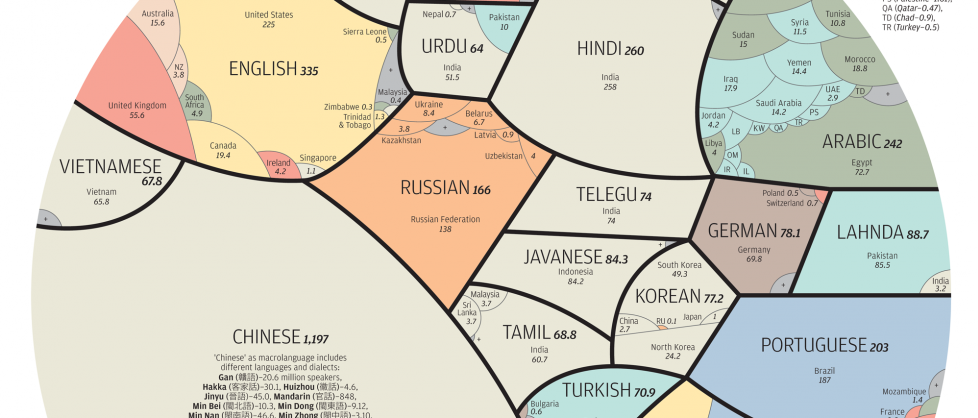Worldwide distribution of languages
A curious infographic of the South China Morning Post, showing not only the current state of affairs in the dissemination of world languages, but also the factors influencing their future. It is especially interesting to look at it, if we keep in mind that language in the modern world = the spread of culture. Those. it is, ultimately, about world cultural diversity, its future and the place of different cultures in this future.

Interesting Facts:
What the infographic says about the Russian language:
If you add to this two facts that are not reflected in the infographic - the growing number of students studying English or Chinese as a foreign language in the countries of the former USSR, and the projected decline in the Russian population to 120 million by 2050 and 100 million by 2100, we can assume that the sphere of influence Russian language and Russian culture will decline. At least, there are no prerequisites for the growth or even maintenance of the status quo.
French is well placed in second place in the number of students learning it. Despite the fact that the total number of speakers is not comparable with Chinese, the native / learned ratio is in their favor, unlike the Chinese, which is probably just too difficult to learn. Yes, the spread of French is now mainly the legacy of the colonial era, due to African countries, but this is not so bad, given the growth potential of African countries in the 21st century, both numerically and economically. Based on a combination of factors, it can be said that French has at least the least chance of becoming a reserve world language than Chinese.
However, while China is the second economy in the world, it also cannot be written off. 30 million Chinese learners are a drop in the bucket, so in the next decades, the demand for learning Chinese should grow.

( larger )
Short summary:

Interesting Facts:
- 7.2 billion people in the world
- For 4.1 billion of them, one of the 23 most widely spoken world languages is native
- Chinese is the most widely spoken mother tongue with 1.2 billion native speakers
- English is the most widely spoken language in the world, taking into account one and a half billion who have learned it - a total of 1.8 billion people speak it
- French and English are the only two, the number of learners which exceeds the number of those for whom he is native
What the infographic says about the Russian language:
- Russian is the eighth most spoken language in the world as a mother tongue for 166 million people
- Russian is the eighth largest country in which it is spoken - 16 countries, including, except for 15 countries b. The USSR is also Mongolia.
- Russian is not included in the top 7 most studied languages on the planet, and in seventh place is Japanese with only three million learners, so no matter how many people learn Russian, there are even fewer
- The Russian language is inferior in the number of speakers of Portuguese - mainly, of course, due to the greatly increased population of Brazil
If you add to this two facts that are not reflected in the infographic - the growing number of students studying English or Chinese as a foreign language in the countries of the former USSR, and the projected decline in the Russian population to 120 million by 2050 and 100 million by 2100, we can assume that the sphere of influence Russian language and Russian culture will decline. At least, there are no prerequisites for the growth or even maintenance of the status quo.
French is well placed in second place in the number of students learning it. Despite the fact that the total number of speakers is not comparable with Chinese, the native / learned ratio is in their favor, unlike the Chinese, which is probably just too difficult to learn. Yes, the spread of French is now mainly the legacy of the colonial era, due to African countries, but this is not so bad, given the growth potential of African countries in the 21st century, both numerically and economically. Based on a combination of factors, it can be said that French has at least the least chance of becoming a reserve world language than Chinese.
However, while China is the second economy in the world, it also cannot be written off. 30 million Chinese learners are a drop in the bucket, so in the next decades, the demand for learning Chinese should grow.

( larger )
Short summary:
- No prerequisites are visible for the growth and even preservation of the sphere of influence of the Russian language
- English threatens nothing as a world language
- French is an unobvious candidate for a backup language
- The Chinese language will be profitable to learn and teach in the coming decades.
